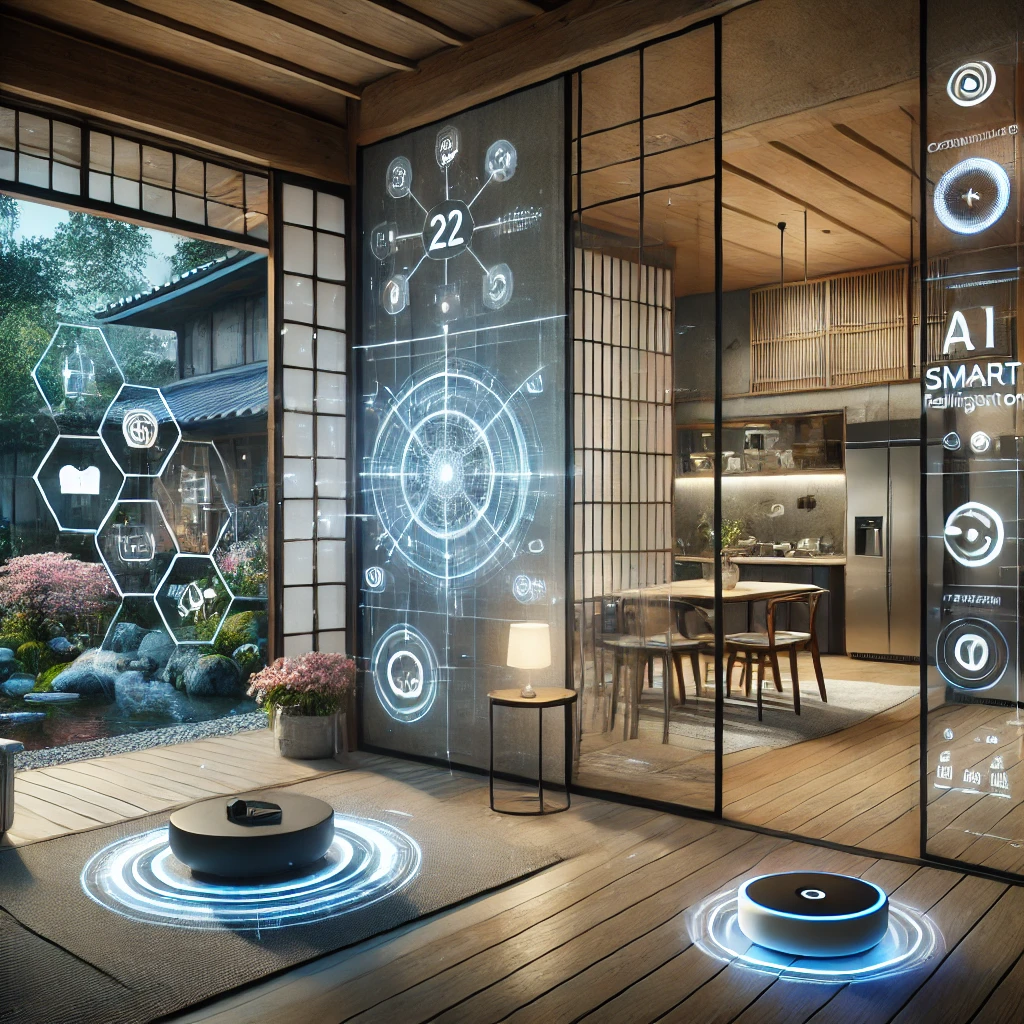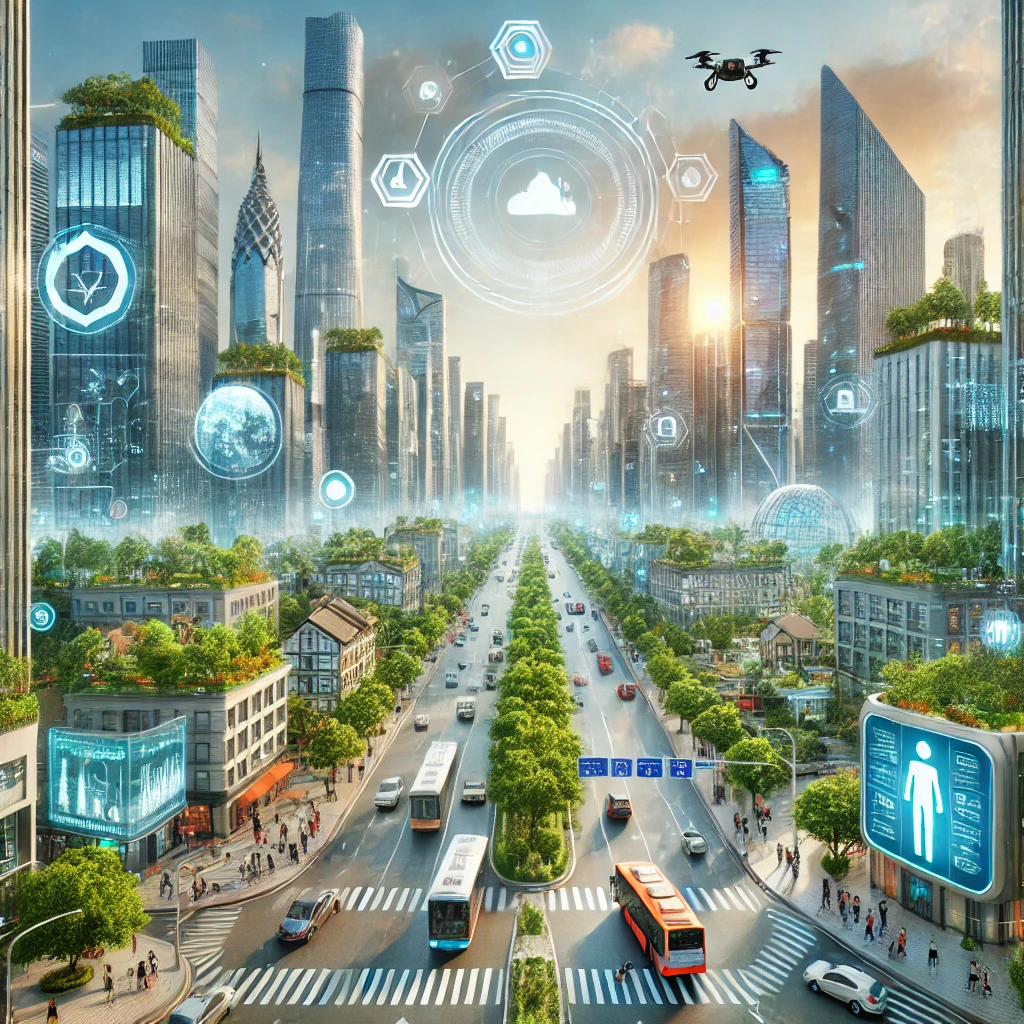Table of Contents
Introduction to Smart Homes in Japan
Smart homes have emerged as a pivotal aspect of modern living, integrating advanced technology to enhance convenience, security, and efficiency in daily life. In Japan, a country renowned for its cutting-edge technological innovations, the concept of smart homes is rapidly gaining traction. The integration of smart home technology reflects a harmonious blend of convenience and cultural values, showcasing Japan’s unique approach to modernization.
As a global leader in technology, Japan has always placed a strong emphasis on innovation, particularly in urban settings where population density and limited space necessitate efficient solutions. The smart home industry in Japan epitomizes this fervor for technological advancement, encompassing various features such as energy management systems, automated appliances, and home security solutions. These tools not only streamline household tasks but also contribute to sustainable living, which is increasingly important in an era of environmental consciousness.
Cultural attitudes towards technology in Japan significantly influence the acceptance and implementation of smart home solutions. The Japanese often regard technology as an essential component of everyday life, seamlessly integrating it into their routines. This perspective nurtures a growing demand for smart solutions among consumers, who prioritize both functionality and aesthetics in their living environments. Moreover, the aging population in Japan further contributes to the desire for innovative living solutions, as elderly individuals seek technologies that facilitate independent living.
Japan’s commitment to creating a future where technology enhances life experiences is evident in its robust smart home market. As advancements continue to roll out, the potential for smart homes to transform living spaces and provide sophisticated, user-centric environments becomes increasingly evident. This exploration will delve deeper into the numerous innovations characterizing the Japanese smart home industry, shedding light on the future of living in Japan.

Key Technologies Powering Japanese Smart Homes
The emergence of Japanese smart homes marks a significant advancement in residential living, characterized by the seamless integration of various technologies. At the core of these innovations is the Internet of Things (IoT), which connects everyday devices to the internet, allowing for real-time data exchange and remote monitoring. This network of interconnected devices plays a vital role in creating a smart ecosystem within the home.
Smart appliances represent one of the most tangible aspects of this technological evolution. These devices, including refrigerators equipped with internal cameras and washing machines that can be controlled via smartphones, not only enhance convenience but also improve energy efficiency. For instance, a smart fridge can suggest recipes based on available ingredients while keeping track of expiration dates. Moreover, many appliances utilize energy management systems to optimize energy usage, reducing costs and minimizing environmental impact.
Automation systems are another crucial element in the framework of Japanese smart homes. These systems facilitate the automation of various household tasks, ensuring a heightened level of comfort. Homeowners can program their lighting, heating, and air conditioning to operate at specific times, adapting to their lifestyle while enhancing energy conservation. For example, automated curtains can close during peak sunlight hours to maintain indoor temperatures, thus reducing the reliance on air conditioning.
Security in smart homes has also reached new heights with advanced home security solutions. Smart cameras, motion sensors, and connected alarm systems provide homeowners with real-time updates and notifications about their property, increasing safety and peace of mind. These solutions are often complemented by mobile applications that enable remote access and management, allowing homeowners to monitor their premises from anywhere in the world.
In conclusion, the convergence of IoT devices, automation systems, and advanced security solutions delineates the way forward for Japanese smart homes. Together, these technologies create an environment that emphasizes convenience, efficiency, and safety, painting a picture of a future where homes are intelligently designed to adapt to the needs of their inhabitants.
Sustainable Living Through Smart Innovations
In recent years, Japanese smart homes have emerged as a paradigm of sustainable living, seamlessly integrating advanced technology to enhance energy efficiency and lessen environmental impact. With a significant focus on eco-friendliness, these homes leverage smarter resource management systems that prioritize sustainability, demonstrating Japan’s commitment to green living.
One of the most notable innovations in this realm is the utilization of energy-efficient appliances and systems. Smart thermostats, for instance, allow homeowners to optimize heating and cooling efforts, automatically adjusting temperatures based on real-time occupancy and weather conditions. This technology not only reduces energy consumption but also promotes comfort. Additionally, solar panels are increasingly incorporated into home designs, enabling residents to harness renewable energy, thereby decreasing their reliance on fossil fuels.
Water management is another crucial area where Japanese smart homes excel. Advanced sensors and automated irrigation systems ensure that water usage is both efficient and sustainable. For example, smart irrigation systems can detect rainfall and adjust watering schedules accordingly, minimizing unnecessary water consumption. Furthermore, greywater recycling systems are being integrated into modern homes, allowing the reuse of water from sinks and showers for irrigation purposes, further encouraging responsible water utilization.
Waste reduction technologies also play an essential role in promoting sustainable living. Smart home devices can track waste generation and offer insights on how to reduce unnecessary waste. The introduction of compacting trash systems and composting units enables residents to manage biodegradable waste more effectively, potentially reducing the strain on local landfills.
Through the integration of these elements—energy conservation, efficient water management, and waste reduction—smart homes in Japan are paving the way for a greener future. By enhancing the quality of life for residents while being mindful of environmental stewardship, these innovations exemplify how technology can catalyze sustainable living practices in today’s world.
Health and Safety Features in Smart Homes
Japanese smart homes are increasingly incorporating various health and safety features designed to enhance the well-being of their residents. These advancements are particularly noteworthy for elderly individuals and those with pre-existing health concerns. One of the most significant components is the smart health monitoring systems, which utilize interconnected devices to track vital signs and general health status in real-time. These systems can monitor heart rate, blood pressure, and even sleep patterns, providing valuable data that can be shared with healthcare professionals, thereby enabling timely intervention if necessary.
Additionally, many smart homes are equipped with emergency response features that ensure quick action in times of need. For instance, these homes may include automatic fall detection systems that can immediately alert family members or emergency services if a resident falls. Such technologies are crucial for the elderly, as they may face a higher risk of injury from falls and may not always be able to reach a phone in an emergency. Smart homes often integrate devices, such as voice-activated assistants, allowing users to request help swiftly by simply speaking to their device.
Moreover, the integration of environmental sensors further enhances safety by monitoring air quality, smoke, and carbon monoxide levels within the home. These sensors can provide real-time alerts to residents, ensuring that any hazardous conditions are promptly addressed. The combination of these health and safety features represents a significant step forward in home automation, directly contributing to the overall quality of life for residents. By implementing cutting-edge technology, Japanese smart homes not only foster convenience but significantly improve health outcomes and enhance safety for vulnerable populations. The evolution of such designs showcases the commitment to integrating modern technology with the fundamental needs of residents.
Case Studies of Innovative Smart Homes in Japan
Japan has emerged as a leader in the development of smart home technology, with various successful case studies showcasing innovative implementations that enhance modern living. One notable example is the “Cocoon House” in Yokohama. This residential space integrates advanced automation systems, allowing homeowners to control lighting, temperature, and security through a central smartphone application. During interviews with the residents, they expressed that the ease of managing their home environment has led to significant energy savings and increased comfort levels. Moreover, the home’s integration of renewable energy sources, such as solar panels, further highlights the potential of smart homes to promote sustainability.
Another remarkable project is the “House of the Future” in Sapporo, which emphasizes the concept of adaptability. Equipped with AI-driven systems, this home can learn and adjust to the lifestyle of its inhabitants. Homeowners noted how the technology provided personalized suggestions for energy usage and maintenance, thereby reducing their overall household expenses. The developers emphasized the innovative use of sensors to monitor environmental conditions, which enables proactive management of home systems, thus enhancing user experience and convenience.
Adding to the diverse landscape of smart homes, there is also the “Living Wall House” in Kyoto, designed explicitly for urban environments. This home features vertical gardens that not only improve air quality but also serve a practical function by providing insulation. Homeowners have highlighted the unique blend of nature and technology, which fosters a soothing living atmosphere. The implementation of smart irrigation systems allows for efficient water usage, ensuring that the gardens thrive with minimal environmental impact.
Through these case studies, it is evident that Japanese smart homes are not just a trend but a reflection of a thoughtful approach to living spaces. They uniquely address the needs of modern homeowners while seamlessly integrating technology to create more functional, sustainable, and user-friendly environments. The insights gained from these innovative projects provide valuable lessons that can inspire future developments in smart home technology around the world.
Challenges Facing Smart Home Adoption in Japan
As Japan rapidly advances into the era of smart home technology, several challenges and barriers impede the widespread adoption of these innovations. One of the most significant hurdles is the high cost associated with implementing smart home systems. While the integration of smart devices can lead to long-term savings on energy and maintenance, the initial investment remains substantial. Many consumers may hesitate to embrace these technologies due to budget constraints or the perceived value of the investment. As a result, this financial barrier could limit the overall market potential for smart home solutions.
Technical complexity also presents a substantial challenge, particularly for less tech-savvy individuals. Many consumers may find the installation and maintenance of smart home devices daunting. The need for a reliable internet connection and a basic understanding of networking can be overwhelming. This complexity may create a reluctance among potential users to engage with smart home technologies, hindering mass adoption in the market. Overall, a user-friendly experience is crucial to ensure wider acceptance and usability of smart devices in household settings.
Privacy concerns further complicate the scenario. Consumers are increasingly aware of the risks associated with data collection and surveillance through smart home devices. Many smart appliances require considerable amounts of personal data to deliver their promised functionalities, which raises apprehensions about potential misuse and breaches of privacy. This anxiety surrounding data security may deter potential users from embracing smart home technology, ultimately impacting consumer interest and growth in the sector.
Moreover, the digital divide prevalent in Japan poses another obstacle. While urban areas may experience rapid technological advances, rural regions often lag behind in terms of internet connectivity and access to smart home solutions. This disparity exacerbates existing social inequalities and creates a significant hurdle for the overall expansion of smart home technology across diverse demographics in Japan.
The Future of Smart Home Technology in Japan
The landscape of smart home technology in Japan is evolving, bearing witness to trends that are expected to shape the future of residential living. As technological capabilities advance, the integration of smart devices into everyday life is predicted to become increasingly seamless. Analysts anticipate that innovations such as artificial intelligence (AI), the Internet of Things (IoT), and enhanced connectivity will play significant roles in the transformation of homes into intelligent ecosystems. For instance, AI-driven systems are expected to enhance energy management, allowing homeowners to optimize energy consumption based on real-time data analysis.
Moreover, evolving consumer preferences are also influencing the direction of smart home innovations. As the population ages, there is a growing demand for smart solutions that enhance safety and provide assistance to elderly residents. Technologies such as automatic lighting, remote health monitoring, and voice-activated systems are becoming essential features in Japan’s smart homes, catering to an aging demographic’s needs. This shift towards user-centric technology underscores the importance of designing products that are intuitive and accessible to all age groups.
The market for smart homes in Japan is projected to expand as consumer awareness increases and prices for smart devices decrease. Additionally, government initiatives aimed at promoting energy efficiency and sustainability are likely to facilitate this growth. Policies encouraging the adoption of smart technologies could incentivize homeowners to invest in energy-efficient appliances and systems, ultimately contributing to Japan’s national goals on reducing carbon emissions. By fostering a culture of innovation and sustainability, Japan is positioning itself at the forefront of the smart home revolution, ultimately creating a future where technology harmoniously integrates into residential life.
Integrating Smart Homes with City Infrastructure
The integration of smart homes with city infrastructure represents a significant leap towards enhancing urban living standards, particularly in Japan. As urban environments evolve, the collaboration between residential technologies and urban infrastructure creates a multifaceted ecosystem that promotes efficiency, sustainability, and enhanced quality of life. This synergy is encapsulated within the broader framework of smart city initiatives aimed at addressing various urban challenges.
Japanese cities are increasingly leveraging advanced technologies to create an interconnected network between residential areas and urban systems. Smart homes equipped with IoT devices collect and share data on energy consumption, water usage, and security. This information is invaluable for city planners and administrators as it allows for real-time monitoring and efficient management of resources. For instance, by analyzing data from smart homes, municipalities can optimize public services such as waste collection, street lighting, and traffic management, thus significantly reducing operational costs and improving service delivery.
Moreover, the integration of smart homes into city infrastructure enhances mobility solutions. Smart homes can interact with public transportation systems, providing residents with efficient travel options based on real-time data. This could involve the use of smart apps that recommend optimal routing based on traffic conditions or dynamically adjusting public transport schedules to accommodate peak demand periods.
Additionally, resource management is profoundly impacted by the convergence of smart homes and urban infrastructure. Through collective efforts, cities can work towards sustainability goals by minimizing energy consumption and promoting renewable energy sources. Smart homes equipped with energy-efficient appliances can contribute to grid stability, thereby lessening the overall carbon footprint of urban areas.
In conclusion, the integration of smart homes with city infrastructure is revolutionizing urban living in Japan. By fostering collaboration between residential technologies and urban systems, cities can enhance resource management, mobility, and overall living standards, paving the way for a more sustainable future.
Conclusion: Embracing the Smart Home Revolution
As we have explored throughout this blog post, Japanese smart homes represent a remarkable fusion of technology and everyday living, paving the way for a future that is increasingly interconnected. The advancements in smart technology, from energy-efficient appliances to sophisticated security systems, are reshaping the residential landscape and contributing to enhanced convenience, safety, and sustainability. These innovations not only make life easier for homeowners but also play a crucial role in addressing broader societal challenges such as energy conservation and urban living efficiency.
The significance of embracing smart home technology is evident, particularly in a country like Japan, which faces unique challenges including a rapidly aging population and limited living space. By adopting smart home solutions, residents can enjoy personalized living experiences tailored to their specific needs. Features such as automated lighting, climate control, and remote monitoring provide comfort and security, thereby enriching the quality of life.

Moreover, as the world moves towards energy-conscious practices, smart homes in Japan serve as a model for sustainable living. The integration of renewable energy sources, such as solar panels, alongside intelligent home management systems, not only reduces carbon footprints but also fosters a more eco-friendly approach to urban lifestyle.
Ultimately, the evolution of smart homes embodies a significant shift in how we conceive of our living spaces. By understanding and valuing the advancements that technology brings, we can transform our homes into more adaptive and responsive environments. It is crucial for individuals and communities to consider the myriad benefits that these innovations present, not just in the context of personal convenience but as a pivotal step towards fostering a more sustainable future for generations to come. Embracing this smart home revolution is no longer a choice; it is an essential pathway to a better tomorrow.





